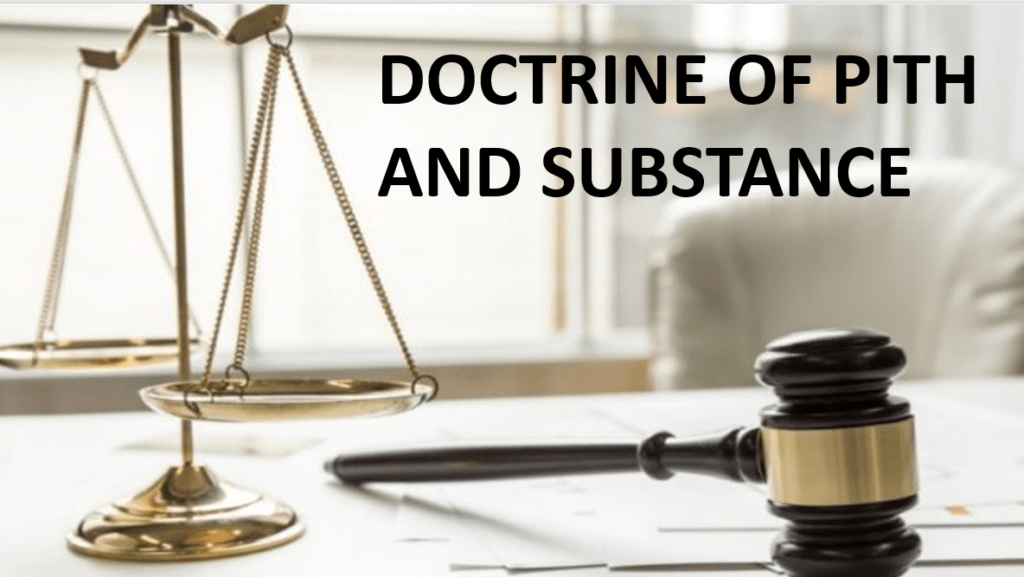
This article is written by Padala Navya Bhanu of 3rd Semester of DSNLU, Visakhapatnam, an intern under Legal Vidhiya
ABSTRACT
The Doctrine of Pith and Substance, a cornerstone in constitutional law, discerns the authentic nature and purpose of legislation to determine its legislative competence. This article traces the historical evolution of the doctrine, exploring its judicial origins as a vital tool for constitutional interpretation. Early pronouncements set the groundwork for its pivotal role in balancing federal and state powers in India, emphasizing its emergence as a fundamental element in maintaining constitutional equilibrium.
Examining the inherent flexibility in India’s federal structure and its alignment with Article 246 of the Constitution, the article scrutinizes the constitutional provision that outlines legislative powers’ distribution between the center and states. By delving into the nuances of Article 246, it illustrates how the Doctrine of Pith and Substance operates within the constitutional framework to resolve potential conflicts, showcasing its practical significance in ensuring cooperative federalism. Despite its consistent application by the Indian judiciary, the doctrine is not without controversy. The article critically explores debates around potential judicial overreach and the subjective nature of identifying the ‘pith and substance’ of legislation, offering a balanced perspective on the challenges associated with this constitutional principle. In conclusion, the article highlights the doctrine’s enduring role in shaping India’s federal structure, emphasizing its importance in upholding constitutional intent while acknowledging ongoing debates and critiques that surround its application.
KEYWORDS
Doctrine of Pith and Substance, Constitutional law, Legislative competence, Constitutional interpretation, Federal structure, Article 246, Cooperative federalism, Government of India Act, 1935, Seventh Schedule, Union List, State List, Concurrent List, Flexibility in federal framework, Judicial origins, Privy Council, Essence and character, True intent, Canadian law, Kartar Singh v. State of Punjab, Landmark judgments, Zameer Ahmed Latifur Rehman Sheikh, v. State of Maharashtra, Consistent application, Assn. of Natural Gas v. Union of India, Subjectivity, Judicial overreach, Form and substance. Legislative manipulation, Structured approach, State of Jammu and Kashmir v. Triloki Nath Khosa, Legal certainty, Separation of powers, Constitutional jurisprudence, Specialized tribunals, Expert panels
INTRODUCTION
The doctrine of pith and substance emerged as a crucial legal principle with the aim of safeguarding against the undue infringement of legislative powers. Its foundational objective lies in assessing the ‘content’ of an enactment to determine its alignment with the subjects allocated to the legislature. This doctrine serves as a tool to establish the legislative competence of a law by scrutinizing its ‘substance.’ If the substance corresponds to the subjects designated for legislative action, the law is deemed entirely lawful. However, if it encompasses subject matter beyond the jurisdiction of the legislature, it may lead to partial or accidental overreach, potentially rendering the statute partially or entirely invalid. The doctrine recognizes the possibility of incidental encroachments when evaluating legislative competency, acknowledging that certain subjects in different legislative lists may overlap.
JUDICIAL ORIGINS AND EARLY INTERPRETATIONS
In its early judicial interpretations, the doctrine of pith and substance was articulated by the Privy Council in cases like Cushing v. Dupey[1] (1880) and Union Colliery Company of British Columbia v. Bryden[2] (1889). Lord Watson, a key figure in shaping the doctrine, emphasized the consideration of the “real essence and character” or the “whole pith and substance” of an enactment. The characteristics of the doctrine highlight the significance of challenging the main topic rather than unforeseen outcomes in a different area. Substance is something’s most important or basic feature, whereas pith is something’s core or true character. Adopting this theory is said to be essential to allow for flexibility in legal interpretations[3] and keep all laws from being declared unconstitutional because they could intrude on the subject matter of another domain. Ultimately, the doctrine aims to identify the genuine nature and substance of legislation to determine its placement within legislative lists and assess the permissible extent of encroachments on legislative powers.
The Government of India Act, 1935, and the present Constitution of India incorporate the idea of pith and substance, which has its roots in Canadian law. The idea of pith and substance is used to determine whether legislative has the jurisdiction to make legislation when it is passed under a particular item in one of the Lists in the VII Schedule. The court looks at the true intent and character of the legislation, assessing whether or not it is consistent with the power of the legislature that passed it, even if it happens to touch on subjects that are under the purview of another legislature. This doctrine plays a crucial role in maintaining the delineation of powers between Parliament and state legislatures, offering flexibility within the federal structure, as overlapping competencies are inevitable.
FLEXIBILITY IN FEDERAL STRUCTURE AND ARTICLE 246
The adoption of the doctrine in India addresses the need for flexibility in a federal framework and prevents excessively restrictive interpretations of legislative powers. Without the application of the pith and substance doctrine, every legislation encroaching on another legislature’s subject matter would risk being declared invalid, hampering the intended purpose of granting legislative powers. The Indian Constitution, particularly Article 246, outlines the distribution of authority between the Union and the States through the Seventh Schedule, categorizing powers into Union List, State List, and Concurrent List. The evolution of these lists through amendments reflects the dynamic nature of legislative powers, with the 42nd Amendment Act[4] in 1976 reshaping the Seventh Schedule to ensure better alignment with contemporary needs.
LEGAL PRECEDENTS AND LANDMARK JUDGMENTS
In the case of Kartar Singh v., the State of Punjab[5] (1961), the Constitutional Bench of the Supreme Court elucidated the application of the doctrine of pith and substance. The court highlighted that when employing this doctrine, legislation pertaining to a specific subject in one of the lists may also have indirect connections to subjects in another list. In such cases, the essential nature and substance of the legislation must be thoroughly examined. If a comprehensive analysis reveals that the law predominantly addresses a topic within the jurisdiction of the relevant legislature, the entire act is considered legal, even if there are unintentional encroachments on other subjects.
The judicial interpretation of the doctrine involves a scrutiny of legislative power, wherein the court assesses the subject matter of the statute in relation to the Union List, State List, and Concurrent List. If the statute falls within the purview of the list corresponding to the legislature in question, it is deemed intra vires and, therefore, lawful. Conversely, if the legislation is found to be unconstitutional, it is declared null and void. In State of Rajasthan v. Vatan Medical and General Store[6] (2001), the court affirmed that once an enactment falls within the confines of an item in List-II (State List), no central law from List I or List III can challenge its legality. The court stressed that Article 246 cannot be invoked to argue the incompetence of the state legislature when the enactment is related to a specific entry in List II.
The case of Zameer Ahmed Latifur Rehman Sheikh v. the State of Maharashtra and Ors[7] (2010) further emphasized the effective application of the pith and substance doctrine. In situations challenging the legislature’s power, the court is tasked with evaluating the essence, purpose, scope, and impact of the law in question. It becomes crucial for the courts to determine whether the legislation genuinely falls within the subject matters listed in the concerned legislature’s jurisdiction.
CONSISTENT APPLICATION BY THE INDIAN JUDICIARY
The Indian judiciary has consistently applied the doctrine of pith and substance when determining the validity of legislative acts. When declaring an Act null and invalid, the judiciary takes into consideration various factors, particularly whether the encroachment on another legislature’s authority was inadvertent or intentional. The Supreme Court, in the case of Assn. of Natural Gas v. the Union of India and Ors[8] (2004), emphasized the importance of understanding what would conventionally be considered “covered within that subject in legislative practice” and the historical practice of the State that conferred such legislative power. This legal theory, well-established in India, has been recognized by different high courts and the Supreme Court. The doctrine of pith and substance is invoked whenever a law is perceived to intrude into an area allocated to another legislative body, with the court scrutinizing the content of the case to determine its applicability to a specific subject listed in one of the lists under the Seventh Schedule. Notably, the Indian judiciary has delivered landmark judgments contributing to the solidification of this doctrine in the Indian constitutional framework.
CRITIQUE AND CONTROVERSIES SURROUNDING THE DOCTRINE OF PITH AND SUBSTANCE
While the doctrine of pith and substance has played a pivotal role in constitutional interpretation, it has not been immune to criticisms and controversies. As with any legal principle, the application of this doctrine has sparked debates and raised concerns among legal scholars, practitioners, and even within the judiciary.
- Subjectivity and Lack of Precision: One prominent critique revolves around the subjective nature of determining the pith and substance of legislation. The doctrine requires judges to look beyond the literal language of a law and discern its true purpose, which can be inherently subjective. Critics argue that this subjectivity introduces an element of uncertainty, leaving room for judicial interpretation that may vary among different benches and over time.
- Potential for Judicial Overreach: The broad discretion afforded to judges in applying the doctrine has led to concerns about potential judicial overreach. Skeptics argue that the doctrine, if not judiciously applied, could provide a pretext for the judiciary to interfere excessively in legislative matters, undermining the separation of powers. The fear is that judges might impose their subjective views on the legislative intent, influencing the outcomes of constitutional challenges.
- Complexity in Distinguishing Form and Substance: The distinction between the form and substance of legislation is a critical aspect of the pith and substance doctrine. Critics contend that this distinction is not always clear-cut, leading to complexities in its application. The challenge lies in determining whether a particular aspect of a law is incidental to its main purpose or if it represents a separate and distinct legislative competence.
- Potential for Legislative Manipulation: Some critics argue that the doctrine’s flexibility opens the door for legislative manipulation. Legislators may draft laws with intentional ambiguity, making it challenging for the judiciary to pinpoint the legislation’s true character. This strategic ambiguity could be exploited to circumvent the constitutional limitations on legislative powers.
- Impact on Legislative Drafting: The doctrine’s influence on legislative drafting is another area of debate. While it encourages precision and clarity in drafting laws, there are concerns that lawmakers might be constrained by the fear of having their legislation struck down on the grounds of pith and substance. This could potentially stifle innovative legislative solutions and limit the dynamic evolution of laws.
NEED FOR A CLEAR METHODOLOGY
Critics advocating for a more structured methodology in the application of the doctrine of pith and substance emphasize the need for clearer guidelines to enhance predictability and consistency in judicial decisions. Currently, the subjective nature of determining the essence of legislation has led to concerns about the lack of a standardized approach. To address this, establishing a more transparent framework could involve specifying factors that courts should consider when evaluating the pith and substance of a law. For instance, a set of criteria such as the legislative intent, the predominant purpose of the law, and the direct and immediate effect on the subject matter in question could be outlined. By providing a checklist of considerations, this structured methodology would offer judges a more systematic approach, reducing the potential for divergent interpretations and ensuring a more uniform application of the doctrine.
For example, in the case of “State of Jammu and Kashmir v. Triloki Nath Khosa,” the Supreme Court grappled with determining whether a state law on land reforms fell within the exclusive jurisdiction of the state or encroached upon matters reserved for the Union. A more structured methodology might have entailed explicit considerations, such as analyzing the historical context of the law, evaluating its primary objective, and assessing its potential impact on subjects falling within the Union List. By following a clear set of principles, the court could have provided a more transparent rationale for its decision, enhancing the overall coherence of its judgment.
CONCLUSION
In conclusion, the doctrine of pith and substance stands as a critical pillar in Indian constitutional interpretation, navigating the complex terrain of legislative competence within a federal structure. While its evolution from Canadian jurisprudence has provided a valuable tool for resolving conflicts between Union and State powers, the doctrine is not without its share of criticisms. The subjectivity in determining legislative intent, potential for judicial overreach, and complexities in distinguishing form from substance have prompted calls for a more structured methodology.
Critics rightly emphasize the need for clearer guidelines to enhance predictability and consistency in judicial decisions. A structured approach could involve articulating specific criteria for evaluating the pith and substance of legislation, providing judges with a systematic framework. Moreover, the establishment of specialized tribunals or expert panels could contribute to a more informed and consistent application of the doctrine.
While the doctrine has been instrumental in maintaining the delicate balance of federalism, its continued relevance necessitates a nuanced and evolving understanding. Striking a balance between judicial discretion and a more structured methodology is essential to uphold the principles of legal certainty, separation of powers, and the dynamic evolution of constitutional jurisprudence in India. As legal scholars, practitioners, and the judiciary engage in ongoing discussions, the doctrine of pith and substance remains a dynamic aspect of the constitutional landscape, shaping the trajectory of Indian governance and legal interpretation.
REFERENCES
- https://byjus.com/free-ias-prep/doctrine-of-pith-and-substance/
- https://www.legalserviceindia.com/legal/article-6766-doctrine-of-pith-and-substance.html
- https://blog.ipleaders.in/doctrine-of-pith-and-substance/
- https://prepp.in/news/e-492-doctrine-of-pith-and-substance-indian-polity-notes
[1] Cushing v Dupuy (Quebec), [1880] UKPC 22: Privy Council, judgment, law, Casemine.com, https://www.casemine.com, https://www.casemine.com/judgement/uk/5b4dc23c2c94e07cccd2315d (last visited Dec 3, 2023).
[2] British Columbia Limited and others v. John Bryden (British Columbia), Privy Council, judgment, law, Casemine.com, https://www.casemine.com, https://www.casemine.com/judgement/in/5779f478e561096c9312ff57 (last visited Dec 3, 2023).
[3] Rachit Garg, Doctrine of pith and substance iPleaders (2022), https://blog.ipleaders.in/doctrine-of-pith-and-substance/ (last visited Dec 4, 2023).
[4] National Portal of India, https://www.india.gov.in/my-government/constitution-india/amendments/constitution-india-forty-second-amendment-act-1976 (last visited Dec 4, 2023).
[5] Case law review: Kartar Singh vs. State of Punjab – Pen acclaims, http://www.penacclaims.com/wp-content/uploads/2023/06/Rajat-Rana.pdf (last visited Dec 5, 2023).
[6] State of Rajasthan vs. Vatan medical and general store, http://www.the-laws.com/Encyclopedia/Browse/Case?CaseId=001002785000 (last visited Dec 5, 2023).
[7] Zameer Ahmed Latifur Rehman … vs the state of Maharashtra, latestlaws.com, https://www.latestlaws.com/judgements/bombay-high-court/2022/march/2022-latest-caselaw-2426-bom (last visited Dec 5, 2023).
[8] Association of Natural Gas vs. Union of India, https://www.the-laws.com/Encyclopedia/Browse/Case?CaseId=004002993000&Title=ASSOCIATION-OF-NATURAL-GAS-Vs.-UNION-OF-INDIA (last visited Dec 5, 2023).
Disclaimer: The materials provided herein are intended solely for informational purposes. Accessing or using the site or the materials does not establish an attorney-client relationship. The information presented on this site is not to be construed as legal or professional advice, and it should not be relied upon for such purposes or used as a substitute for advice from a licensed attorney in your state. Additionally, the viewpoint presented by the author is of a personal nature.




0 Comments